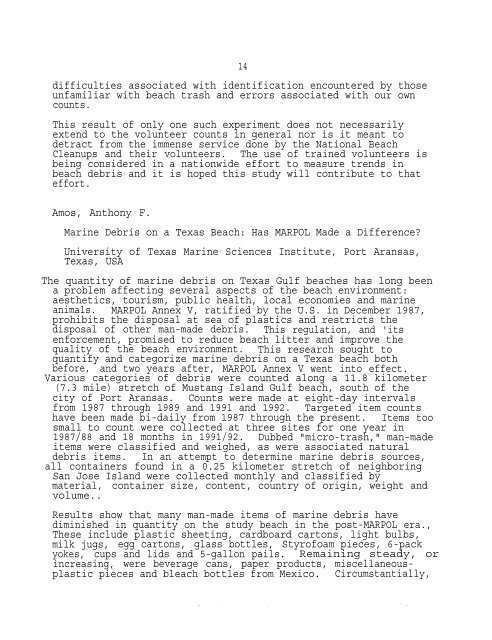Poster abstracts and manuscripts from the Third International ...
Poster abstracts and manuscripts from the Third International ...
Poster abstracts and manuscripts from the Third International ...
You also want an ePaper? Increase the reach of your titles
YUMPU automatically turns print PDFs into web optimized ePapers that Google loves.
14<br />
difficulties associated with identification encountered by those<br />
unfamiliar with beach trash <strong>and</strong> errors associated with our own<br />
counts.<br />
This result of only one such experiment does not necessarily<br />
extend to <strong>the</strong> volunteer counts in general nor is it meant to<br />
detract <strong>from</strong> <strong>the</strong> immense service done by <strong>the</strong> National Beach<br />
Cleanups <strong>and</strong> <strong>the</strong>ir volunteers. The use of trained volunteers is<br />
being considered in a nationwide effort to measure trends in<br />
beach debris <strong>and</strong> it is hoped this study will contribute to that<br />
effort.<br />
Amos, Anthony F.<br />
Marine Debris on a Texas Beach: Has MARPOL Made a Difference?<br />
University of Texas Marine Sciences Institute, Port Aransas,<br />
Texas, USA<br />
The quantity of marine debris on Texas Gulf beaches has long been<br />
a problem affecting several aspects of <strong>the</strong> beach environment:<br />
aes<strong>the</strong>tics, tourism, public health, local economies <strong>and</strong> marine<br />
animals. MARPOL Annex V, ratified by <strong>the</strong> U.S. in December 1987,<br />
prohibits <strong>the</strong> disposal at sea of plastics <strong>and</strong> restricts <strong>the</strong><br />
disposal of o<strong>the</strong>r man-made debris. This regulation, <strong>and</strong> 'its<br />
enforcement, promised to reduce beach litter <strong>and</strong> improve <strong>the</strong><br />
quality of <strong>the</strong> beach environment. This research sought to<br />
quantify <strong>and</strong> categorize marine debris on a Texas beach both<br />
before, <strong>and</strong> two years after, MARPOL Annex V went into effect.<br />
Various categories of debris were counted along a 11.8 kilometer<br />
(7.3 mile) stretch of Mustang Isl<strong>and</strong> Gulf beach, south of <strong>the</strong><br />
city of Port Aransas. Counts were made at eight-day intervals<br />
<strong>from</strong> 1987 through 1989 <strong>and</strong> 1991 <strong>and</strong> 1992. Targeted item counts<br />
have been made bi-daily <strong>from</strong> 1987 through <strong>the</strong> present. Items too<br />
small to count were collected at three sites for one year in<br />
1987/88 <strong>and</strong> 18 months in 1991/92. Dubbed "micro-trash," man-made<br />
items were classified <strong>and</strong> weighed, as were associated natural<br />
debris items. In an attempt to determine marine debris sources,<br />
all containers found in a 0.25 kilometer stretch of neighboring<br />
San Jose Isl<strong>and</strong> were collected monthly <strong>and</strong> classified by<br />
material, container size, content, country of origin, weight <strong>and</strong><br />
volume..<br />
Results show that many man-made items of marine debris have<br />
diminished in quantity on <strong>the</strong> study beach in <strong>the</strong> post-MARPOL era.,<br />
These include plastic sheeting, cardboard cartons, light bulbs,<br />
milk jugs, egg cartons, glass bottles, Styrofoam pieces, 6-pack<br />
yokes, cups <strong>and</strong> lids <strong>and</strong> 5-gallon pails. Remaining steady, or<br />
increasing, were beverage cans, paper products, miscellaneousplastic<br />
pieces <strong>and</strong> bleach bottles <strong>from</strong> Mexico. Circumstantially,
















